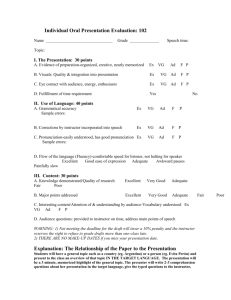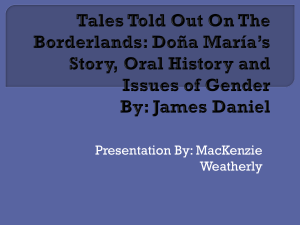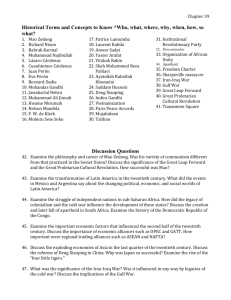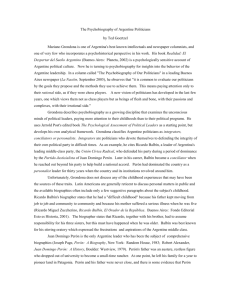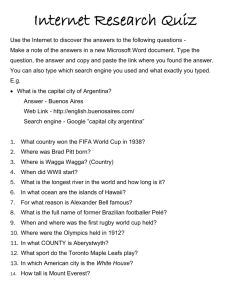Argentina before Perón
advertisement
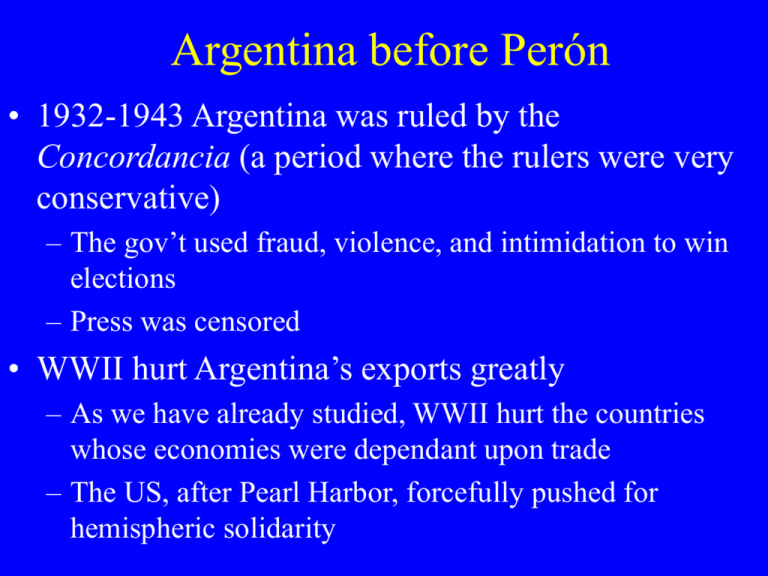
Argentina before Perón • 1932-1943 Argentina was ruled by the Concordancia (a period where the rulers were very conservative) – The gov’t used fraud, violence, and intimidation to win elections – Press was censored • WWII hurt Argentina’s exports greatly – As we have already studied, WWII hurt the countries whose economies were dependant upon trade – The US, after Pearl Harbor, forcefully pushed for hemispheric solidarity Argentina before Perón – Many Argentines viewed the US with hostility because of years of competition over the sale of grain and beef to European markets and b/c Argentine goods were blocked from the US market by high tariffs • Many Argentine military officers were pro-German – This came from training by ze Germans and the admiration of supposed German success – Even more though, the Argentines held the belief that the English and Americans had worked together to keep Argentina a rural economy – In 1943, it seemed as if ze Germans were going to control Europe for quite some time and the Argentines would benefit from this so they remained neutral throughout WWII so as not to cut off any options Argentina before Perón • During this time, Brazil was receiving a lot of economic and military aid from the US and Argentina feared conflict with the Brazilians – This fear led the nationalists to believe that funds should be poured into a new domestic military arms industry – Pres. Ramón Castillo refused to allocate funds to the military which caused the nationalists, along with radicals and liberals to oppose Castillo – As the election of 1943 approached it appeared the Castillo would manipulate the election for Robustiano Patrón Costas, who was the most conservative member of the Concordancia Argentina before Perón – Although there were no official statements, the nationalists were convinced that if elected Costas would end Argentine neutrality and enter against the Axis Powers. – All of this uncertainty led to a military coup that overthrew the Castillo regime on June 6, 1943. • After the coup, General Pedro Ramírez became Pres. – Late 1943, the US placed new financial and trade restrictions on Argentina and pressured other Latin American countries to do so also – The US also increased aid to Brazil and many nationalists believed the conflict would happen soon Argentina before Perón – In desperation the Ramírez gov’t sent an emissary to negotiate with Germany • The British captured that agent • In an attempt to avoid a total break with the US and England, Ramírez agreed to sever relations with the Axis powers by January 1944. • Fearing that this agreement (b/c it broke relations with ze Germans) would end neutrality, the nationalists in gov’t forced Ramírez to resign and made his VP, General Edelmiro Farrell, Pres. Argentina before Perón • The war’s disruption of international trade meant that Argentina lacked the capital to have economic and social stability. – To make sure Import Substitution Industrialization worked the gov’t thought it needed to have a submissive labor class. Since many union leaders were socialist and or communist the first plan of attack was against labor. • The gov’t took over labor unions, suppressed newspapers, and jailed opposition leaders. • This policy of direct confrontation with labor led to protests and strikes and threatened to wreck the armies industrialization program. Juan Perón • Juan Perón was born the son of a farmer in 1895 – He attended the National Military School in 1911 – He was highly respected in the military by the 1930’s and he served as Argentina’s military attaché to Italy where he learned under Benito Mussolini – After the 1943 coup he was put in charge of the Labor Dept. (Later expanded into the Secretariat of Labor and Social Welfare) – With the overthrow of Ramírez, Perón became the VP and minister of war. Juan Perón • Perón’s brilliance lay in his recognition of women, ethnic minorities and the labor class to gain public support for the military’s industrialization program. – He believed the military should form an alliance with the labor class – Late 1943: Perón convinced the military to adopt this policy of embracing the labor class. • Perón created the Women’s Division of Labor and Assistance under the Secretariat of Labor and Social Welfare – Perón said that the 900,000 women laborers conditions needed to be monitored by the gov’t and in many cases improved. • In any strike, Perón always sided with the unions and gained their support quickly Perón – Thanks to Perón labor turned from a threat to an ally – It also meant that the increased purchasing power of the many urban workers benefited the process of industrialization • Perón’s policies created considerable opposition within some factions of the military, the oligarchy, and the business leaders – It also cost him support from right-wing military officers and there were public attacks on him as the most visible person of the junta – In an attempt to defuse the situation, Farrell had Perón arrested and jailed in October 1945. Perón – A massive Buenos Aires demonstration by Perón’s supporters and maneuvering by his allies within the military had him out of jail in 5 days and Farrell reinstated Perón to his previous position • In an attempt to end the crisis Farrell scheduled an election for Feb. 1946 • Perón established the Partido Laborista (Labor Party) and began his campaign for the presidency – During the campaign, US ambassador Spruille Braden widely distributed a pamphlet called the “Blue Book” that claimed Perón was most likely a fascist and an Axis sympathizer. This was in the hope of weakening Perón’s campaign; it backfired. – Perón came out with the “Blue and White Book” (Argentina’s colors) which claimed his enemies were the tools of the Yankees and he ran the rest of his campaign under the slogan “Braden o Perón”. Perón • Perón won the election with 54% of the vote. – It is considered a fair election. • His wife Eva Duarte was also influential in his time as president. • We will not have time to watch the film in class. Therefore, I will show it at midblock. I will give 5 points extra credit per visit to watch the film. The film will begin Thursday at midblock. Perón • Perón used the military to stay in power. – He increased military spending and ended the draft. – The number of officers increased and many of them were given control of key industries and gov’t agencies. – To maintain his power among the labor class Perón’s gov’t established the following: • • • • Minimum wage Controlled length of workday Made it difficult for employers to fire workers Established working condition regulations in major industries – Unions not affiliated with the gov’t were allowed to exist but any strikes were thwarted by the gov’t and the members were not given benefits that recognized unions did Perón – As a result of Perón’s tactics, non-recognized unions quickly dissolved – Perón also removed anyone who opposed him from positions of power and influence • In 1947, Perón disbanded the Partido Laborista and created the Sole Party of the National Revolution • One of Perón’s greatest allies, as we know, was his wife Eva (Evita). – She helped Perón’s regime to connect the urban poor (descamisados- “shirtless ones”) and women – Through her aid foundation she gave out large sums of money to women’s groups and the impoverished Perón – Perón had Congress pass legislation that increased women’s access to university and improved their working conditions – In 1951. 90% of the eligible women voted in the election and 65% cast their vote for Perón • Prior to the 1946 election the junta had taken control of the Central Bank and established price and production boards – This action along with new currency and banking regulations gave Perón complete independence in Argentina’s new fiscal policy – Perón supported industrial investment and expansion in hopes of strengthening Argentina and tie laborers and industrialists to Perón – Perón and his supporters believed if Argentina could develop industry that it would protect them in an economic crisis Perón – Initially, Perón‘s economic program was successful • From 1949 on, Perón’s programs were less successful – Argentina and the US were competing in the sale of beef and wheat – Europe was devastated by WWII so Argentina could not trade with any of those countries – Instituto Argentino de Promoción del Intercambio (Argentine Institute for the Promotion of Trade, aka IAPI) was formed to help create new industries Perón – Perón also used the IAPI to purchase foreign owned assets and to promote himself as the protector of Argentina nationalism – According to Perón, the centralized, planned development of Argentina’s economy represented a middle way between Communism and capitalism Perón’s fall from Power • Severe recession and drought-induced bad harvests after 1949 will lead to Perón’s downfall – The 1948 US Marshall Plan gave loans to western Europe that could only be used in the US or Canada – Argentine farmers were receiving less money for their export crops than the gov’t was receiving from foreign countries • As a result, many farmers switched from corn and wheat (whose prices were controlled by the IAPI) to non-price controlled cattle feed crops of oats and alfalfa.(http://www.pacificislandtravel.com/south_america/arge ntina/about_destin/wpeC4.jpg) Perón’s fall from Power – Real wages dropped 20% from 1949-1952 as inflation reached 30% per year. – Perón abandoned his ultra-nationalistic program and actively solicited foreign investment • Foreign capital used modern technology and machines which tended to create unemployment in the affected industrial sectors • In order to maintain gov’t expenditures and a bloated bureaucracy and military in the face of declining revenues, the gov’t printed more money – The circulation amount went from 6 billion to 45 billion pesos Perón’s fall from Power • Perón attempted to divert attention from the economic issues with terrible results – The regime grew more repressive – He used his National Liberating Alliance, a private army of thugs, and the federal police force to intimidate political opposition • Torture, imprisonment, censorship, and exile for opponents became commonplace. – After Evita’s death, Perón tried to make the Catholic church recognize her as a saint Perón’s fall from Power – This attack on the church further antagonized the military that was already frustrated by his cult of personality and the promotion of men due to their support and loyalty and not their ability – Perón’s labor class support declined as inflation reduced the value of their pay – The last straw for the nationalist military was the selling of oil rights to Standard Oil in 1953 • Perón’s multi-class coalition was gone and his power was in serious jeopardy Perón’s fall from Power • September 1955: military coup takes place and Perón is ousted and exiled to Spain – Perón solved none of Argentina’s major economic problems – The nation’s transportation system continued to be inadequate and obsolete – The scarcity of electricity made industrial modernization next to impossible – Argentina did not produce enough coal, oil and natural gas to meet domestic needs and this created a drain on the balance of payments – Industry remained limited for the most part to import-substitution light industry – Perón did nothing to break the control of the hacienda owners on Argentina’s agricultural production STRETCH!! Argentina after Perón • After Perón was exiled Argentina had several problems: – Chronic inflation – Large budget deficits – Significant trade imbalances • Because of the way Perón set up the gov’t (system of gaining political support from the urban masses and not sustain economic development) all of the problems lead to social upheaval as one gov’t after another attempted to deal with the legacy of Perón. Argentina after Perón • 1955-58 the military ran the country. • The Peronist party and Peronist labor unions were outlawed and arrested. • The army dictatorship solved none of Argentina’s economic problems and its repression of Peronism created significant opposition to the regime. • 1958: elections allowed and Aruro Frondizi was elected pres. • 1962: Frondizi allowed the Peronist party to run as long as Perón himself did not run – The Peronists won 10 governorships and the majority in the country’s provisional legislatures – 1963: because of the strong Peronist showing the military arrested Frondizi and bans the Peronists, reestablishing the military junta. Argentina after Perón • The military was split between conservatives who did not trust politicians to lead the country out of the economic mess and liberals who believed in representative democracy. – Everyone in the military agreed changes to the economy were necessary. • Problem: genuine democracy could not exist without Peronists since they represented the majority of the people. • And yet it was the Peronists that blocked any reforms. • Election 1963: Arturo Illia won – He also legalized the Peronist party and they won the congressional elections – The military overthrew Illia in 1966 Argentina after Perón • General Juan Carlos Onganía became pres. – Onganía used Franco’s Spanish model to create reforms in his so called “Argentine Revolution” • Military would keep order • The technocrats would modernize the country – Onganía viewed universities as hotbeds for liberalism and Marxism so he put them under state control. – Onganía’s plan seemed to work • Inflation fell from 30 to 10% • Farm exports generated revenue for the gov’t and hard currency for industrial improvements. • High tariffs protected Argentine industries. Argentina after Perón • Underneath the surface all was not well. – Farmers resented the export taxes on their goods. – Scheduled devaluation of the Argentine peso made imports more expensive and angered consumers and industrialists – Wages were frozen and workers, naturally, protested – May 1969 in Córdoba: students and auto workers rioted because of the economic condition and the gov’ts control of higher education • Known as the cordobazo, the two days of rioting lead to the occupation and trahing of gov’t buildings. – The army finally restored order Argentina after Perón • The cordobazo lead Peronists and Marxists to believe the only method to overthrow the right wing military was direct violent action. • June 1970: Onganía removed from power and a new military junta took control • 1970 Argentina was socially, politically, and economically divided. – In 1973, the junta legalized the Peronist party and allowed Perón back to Argentina. – The myth of Perón was greater than the man. • He was in his 70’s and ailing • His new wife, Isabel (Panamanian night club dancer) was no Evita • Peronist Party was fractured – On the right were “middle grounders”-fascists – In the middle: those who favored representative democracy – Left: the youth who favored a violent “war of national liberation” » They called themselves the Montoneros (a name taken from the mounted soldiers during the wars for independence) Argentina after Perón • 9/1973: Perón elected pres. With 62% of the vote – His wife elected VP – Perón reinstated many of the 1940’s economic policies and spoke out against the left-wing of his movement – Before he could take any action against the lefties in his party he died (July 1, 1974) leaving Isabel pres. (unprepared) • 1960’s left-wing indurgency developed – The Montoneros were active in urban areas – The Ejército Revolucionario del Pueblo (Revolutionary Army of the People, ERP) was the main force in the countryside • To get cash for their activities the Montoneros would kidnap political leaders for ransom and rob banks. • “Enemies of the people” were assassinated. • The ERP attacked military and police sites. Argentina after Perón • In Nov. 1974 the military convinced Isabel to declare a state of emergency. – This allowed the military to go after the guerrillas with little regard fro civil liberties. – They worked with the Alianza Argentina Anticomunista (Argentine Anticomunnist Aliance, AAA) in an offensive known as the “Dirty War” • Death squads detained, tortured and murdered anyone they suspected of subversion – Estimates place the number of “disappearances” in this time period at 10,000 to 20,000 • 1976: the military deposed Isabel • They had no solutions and Argentina remained stagnant Argentina after Perón • Dec. 1979 General Leopoldo Galtieri became pres. • He wanted to tie the military to nationalism to take the people’s minds off the economic problems and to broaden support for the gov’t – Since independence Argentina claimed the Malvinas (Falklands) Islands located off the coast of Argentina. • England controlled the islands since 1833 • The English used these islands for whaling and coaling stations in the 19th and early 20th centuries but the population of 2100 were in the 1980’s mostly sheepherders. Little strategic value to the English – April 2, 1982 Argentina moved into and occupied the islands Argentina after Perón • The occupation was initially popular among the people. – But things did not fo as planned – England refused to give up the islands. • They sent a naval force to deal with it. They blocked any Argentine reinforcements. – The US failed to intervene and then sided with the English, blocked arms sales to Argentina and offered the English logistical support • 72 day war a total defeat for Argentina • Cost of the totally meaningless war: – England: 255 men, 7 ships, 10 fighter jets, 23 helicopters – Argentina: 635 men, 10,000 captured, 1 cruiser, 1 submarine, several supply boats, air force lost 109 aircraft Argentina after Perón • The war completely discredited the gov’t and the military. Galtieri resigned and the army promised a return of democracy. • 1983-1995 • Raúl Alfonsin of the Radical Party was elected pres. In 1983 – In addition to the economic crisis Alfonsin had to deal with bringing to justice those responsible for the “Dirty War” – Even before the fall of the junta, the Las Madres de Plaza de Mayo (Mothers of the Plaza de Mayo, Los Madres) demanded an accounting of the “diappeared” – Military claimed their actions were just considering the internal violence at the time – Alfonsin agreed to block any prosecution of those ordered to commit human rights violations during the Dirty War. However, those who made the orders were prosecuted and sent to prison Argentina after Perón • Side note: 1996- an ex-naval officer to ld of “death flights” where leftists were drugged and thrown from the plane in the Atlantic ocean. • 1989: Peronists regained control when Carlos Menem became pres. – Relected in 1995 – He was no more successful than his predecessors at solving any issues – Since 1983, Argentina has been a democracy. • Sadly, no group has been able to fix any problem. • Gov’t corruption is widespread, inflation still a problem, debt is growing, banking is in constant danger of collapse, 14% has a high school diploma, only 4% are college grads, military is lurking always, agriculture is not productive when compared to other industrial nations, and industrial growth is not self-sustaining. – Argentina’s future looks like a continuation of the past with no solutions in sight.
